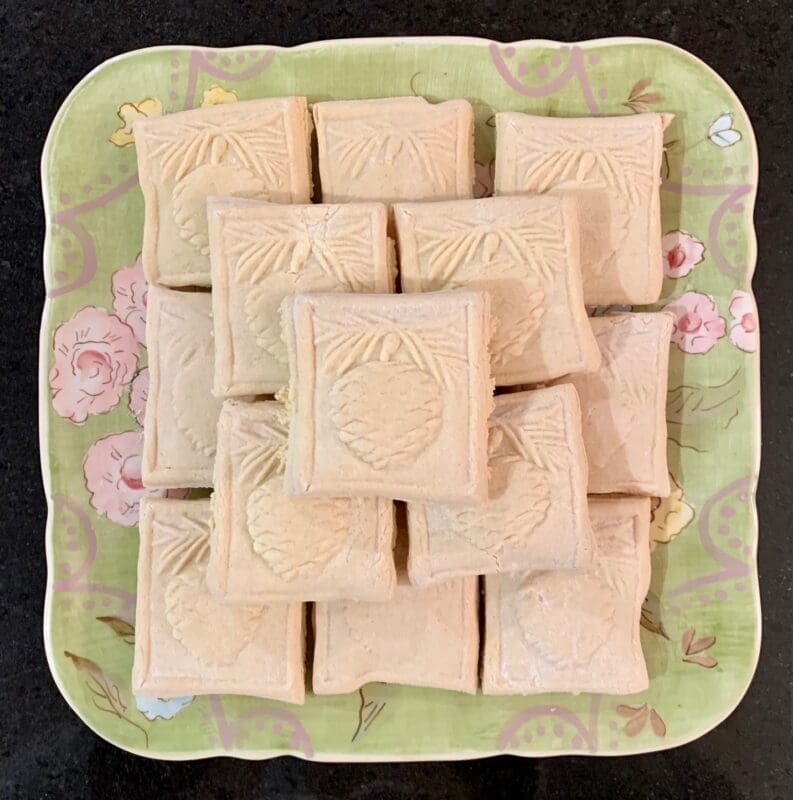
Springerle Cookies: The Elegant, Embossed Biscuit
Among the many delights that grace our holiday table, few carry the historical gravitas or artistic beauty of our German heritage. These pale, molded biscuits are more than just cookies — they’re edible heirlooms, steeped in centuries of tradition.
A Taste of History
The Springerle cookie traces its lineage back to the 14th-century, where it was crafted as a token of religious reverence and celebration. The cookie’s ornate surface — pressed with hand-carved molds or rolling pins — served as a canvas and over time, the cookie evolved into a cherished Yuletide treat, particularly beloved by those fond of the distinctive aroma and flavor of anise.

The Art and Alchemy of Springerle Cookies
What sets Springerle apart is its striking visual appeal, the crisp but chewy texture and the unmistakable flavor of anise. Each cookie is a small, surface embossed masterpiece. The dough holds the impression, a quality achieved by allowing the cookies to rest and dry before baking.
Springerle cookies are often made weeks in advance of Christmas and stored in tins, allowing their flavor to develop and deepen. The anise is assertive but never overwhelming, making this a favorite for those who appreciate its nostalgic, old-world flavor profile.
What’s in a Name?
The etymology of Springerle remains something of a culinary mystery. Direct translations from German yield little clarity, as the word resists interpretation. However, one theory offers a poetic possibility. The name may reference the way the cookies rise in the oven. In German, “springen” means “to jump” or “spring up,” an apt description of the cookie’s behavior while baking.
Baking with Tradition
To make Springerle is to participate in a centuries-old tradition that takes time, patience, and a gentle hand. Molds are often passed down through generations. Yet for those who undertake the task, the reward is more than just a cookie. It is a connection to the past, a celebration of craftsmanship, and a moment of quiet beauty in the bustling holiday season.
Whether enjoyed alongside a cup of coffee or mulled wine, Springerle cookies offer a timeless indulgence. They are the rare confection that feeds the soul as much as the senses — fragrant with history, tradition, and the unmistakable scent of anise.
Springerle Cookies
German anise flavored biscuits (cookies)!
- Prep Time: 45
- Cook Time: 25
- Total Time: 1 hour 10 minutes
- Yield: 48 1x
Ingredients
- 1 TBL anise seeds – crushed or ground
- 3–1/2 cups all-purpose flour
- 1/4 tsp salt
- 1 tsp baking powder
- 4 large eggs – room temperature
- 2 tsp anise extract
- 2 cups fine granulated sugar
- 1/2 tsp vanilla extract
- unsalted butter
Instructions
- Cover 2 cookie sheets with parchment paper and lightly grease with butter
- Evenly sprinkle the crushed anise seed onto the parchment paper
- Sift the flour, salt and baking powder together
- In your mixer bowl, beat the eggs, vanilla and anise extract together, then slowly add the sugar
- Beat on high until foamy and doubles in volume, about 8-10 minutes
- Change to a dough hook and slowly mix in the flour until you get a thick dough. If the dough is too thin and wet, add a little more flour
- Knead the dough on a floured surface into a ball until it is a thick coherent dough
- Cut the ball in half and knead into two balls. Wrap the second ball to prevent it from drying out until ready to use
- Roll out the dough of the first ball on a lightly floured surface to 1/4″ thick
- Lightly flour the dough on top and form the cookies by pressing the springerle mold or rolling pin hard enough to leave the imprint
- Knead the scraps together and repeat the process until the dough from the first ball is used up
- Cut the cookies apart with a knife, pastry or pizza cutter
- Place the cookies on the baking sheet on the crushed anise and repeat the process until all the dough is used then cover the cookies with a light cloth and allow to dry 12-24 hours
- Preheat the oven to 300, bake 25 minutes until the tops are crisp, but the centers remain spongy
- Remove from the oven and cool on a rack for 15-20 minutes
- Package and store in airtight container(s)
Notes
They will be pretty hard initially. Let them rest in the containers for a day or two and they will soften enough to be just right!

